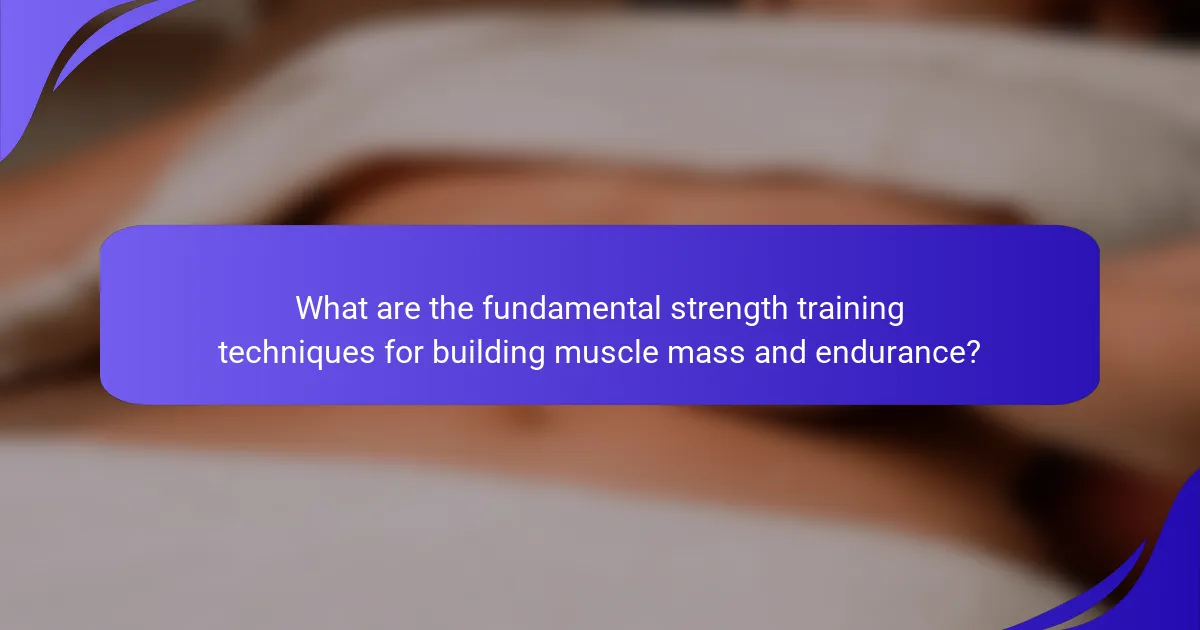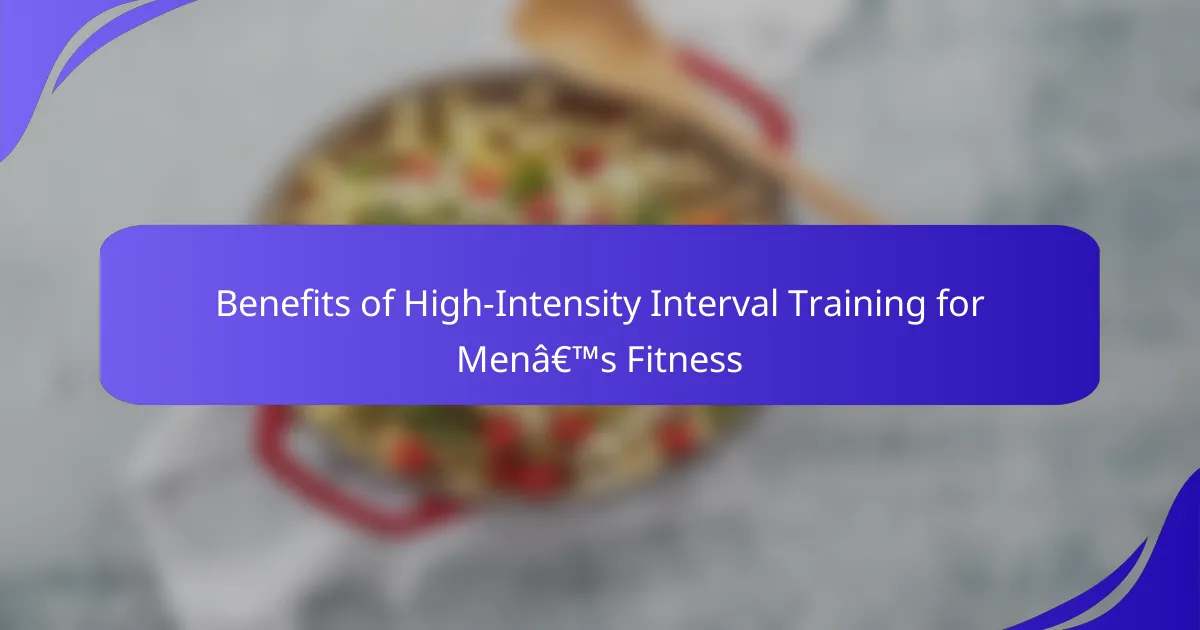Building muscle mass and endurance requires effective strength training techniques. Key methods include progressive overload, compound exercises, and high-intensity interval training. Advanced techniques like cluster sets and eccentric overload can further enhance results. Regional preferences and access to equipment also shape training approaches, influencing exercise selection and styles.

What are the fundamental strength training techniques for building muscle mass and endurance?
Strength training techniques for building muscle mass and endurance include progressive overload, compound exercises, and proper recovery. Progressive overload gradually increases weight or resistance, promoting muscle growth. Compound exercises like squats and deadlifts engage multiple muscle groups, enhancing strength and endurance. Adequate recovery, including rest days and nutrition, supports muscle repair and growth, optimising training results.
How does progressive overload contribute to muscle growth?
Progressive overload is essential for muscle growth as it continually challenges muscles, leading to adaptations. By gradually increasing weights or resistance, muscles experience stress that stimulates hypertrophy. This technique enhances strength and endurance over time, promoting overall fitness. Regularly adjusting intensity ensures sustained growth and prevents plateaus.
What role does volume play in strength training?
Volume is crucial in strength training as it directly influences muscle growth and endurance. Higher volume, achieved through increased sets and repetitions, stimulates greater muscle fibre recruitment. This leads to enhanced hypertrophy, allowing muscles to adapt and grow stronger over time. Optimal volume varies among individuals, but generally, 10-20 sets per muscle group per week is effective for most. Balancing volume with intensity ensures comprehensive development, preventing plateaus.
How can intensity be effectively managed in workouts?
To effectively manage intensity in workouts, incorporate progressive overload, varied rep ranges, and adequate rest periods. These strategies enhance muscle growth and endurance while preventing injury.
Start by gradually increasing weights or resistance to challenge muscles. For example, use a mix of low-rep, high-weight sets for strength and high-rep, low-weight sets for endurance.
Rest between sets is crucial; 30-90 seconds for endurance-focused workouts and 2-5 minutes for strength training. This balance allows for recovery while maintaining workout intensity.
Finally, listen to your body. Adjust intensity based on fatigue levels, ensuring workouts remain effective and sustainable.

What unique techniques enhance muscle mass and endurance?
Strength training techniques that enhance muscle mass and endurance include progressive overload, compound exercises, and high-intensity interval training. Progressive overload involves gradually increasing weights or resistance, promoting muscle adaptation. Compound exercises like squats and deadlifts engage multiple muscle groups, maximising strength gains. High-intensity interval training boosts endurance by alternating short bursts of intense activity with rest, improving cardiovascular fitness. These techniques collectively foster significant muscle growth and endurance enhancement.
How does circuit training differ from traditional strength training?
Circuit training emphasises high-intensity, time-efficient workouts that combine strength and cardiovascular exercises, while traditional strength training focuses on lifting weights to build muscle mass and strength. Circuit training typically involves performing multiple exercises in succession with minimal rest, enhancing endurance and calorie burning. In contrast, traditional strength training often includes longer rest periods between sets, allowing for heavier lifting. The unique attribute of circuit training is its ability to improve both muscle endurance and cardiovascular fitness simultaneously.
What are the benefits of supersets in muscle building?
Supersets enhance muscle building by increasing workout intensity and efficiency. They involve performing two exercises back-to-back with minimal rest, which boosts muscle fatigue and metabolic stress. This technique can lead to greater hypertrophy due to increased time under tension. Additionally, supersets save time, allowing for more exercises in a shorter period, which is beneficial for those with tight schedules.
How can plyometrics improve strength and endurance?
Plyometrics enhance strength and endurance by improving muscle power and efficiency. These explosive movements, such as jump squats and box jumps, engage fast-twitch muscle fibres, leading to increased muscle mass and improved cardiovascular performance. As a result, athletes can perform better in endurance activities, benefiting from enhanced overall athleticism. Regular plyometric training can lead to significant improvements in both strength and endurance metrics.

What rare techniques can be employed for advanced strength training?
Advanced strength training can benefit from rare techniques like cluster sets, accommodating resistance, and eccentric overload. These methods enhance muscle engagement and promote hypertrophy.
Cluster sets involve short rest periods within a set, allowing for increased intensity and volume. Accommodating resistance uses bands or chains to modify load throughout the lift, maximising strength at different angles. Eccentric overload focuses on the lowering phase of a lift, promoting greater muscle damage and growth.
Incorporating these techniques can lead to substantial improvements in muscle mass and endurance.
What is the role of blood flow restriction training?
Blood flow restriction training enhances muscle growth and endurance by restricting blood flow during exercise. This technique stimulates hypertrophy through metabolic stress, allowing for effective strength gains with lighter weights. Research indicates that it can produce similar muscle mass increases as traditional heavy lifting, making it a unique attribute of modern strength training. Additionally, it may aid in recovery and rehabilitation, offering a rare benefit for those with injuries.
How does eccentric training differ from conventional methods?
Eccentric training emphasises muscle lengthening under tension, while conventional methods often focus on concentric movements. This distinction enhances muscle hypertrophy and strength. Eccentric training typically involves slower movements, promoting greater muscle damage and adaptation. As a result, athletes may experience improved performance and reduced injury risk.
What are the benefits of using isometric exercises?
Isometric exercises enhance muscle strength without joint movement. They improve stability, increase endurance, and can be performed anywhere. These exercises are effective for injury rehabilitation and can build muscle mass over time. Additionally, they engage multiple muscle groups simultaneously, promoting overall functional strength.

How can regional preferences influence strength training techniques?
Regional preferences significantly shape strength training techniques, affecting exercise selection and training styles. For instance, cultures emphasising aesthetics may prioritise bodybuilding methods, while regions valuing functional fitness might focus on compound movements.
Local access to equipment and facilities can also dictate training approaches. Urban areas may have more specialised gyms, influencing the use of advanced techniques. Conversely, rural regions might favour bodyweight exercises due to limited resources.
Additionally, climate impacts outdoor training preferences. Warmer regions may encourage outdoor workouts, while colder climates often lead to indoor training adaptations. These factors collectively influence how strength training is approached across different regions.
What are the most popular strength training methods in different cultures?
Strength training methods vary across cultures, each emphasising unique techniques. In the United States, weightlifting and powerlifting dominate, focusing on building muscle mass and strength. In Japan, martial arts incorporate strength training through bodyweight exercises and resistance training, promoting endurance and agility. Meanwhile, in ancient Greece, the use of stone lifting and calisthenics was prevalent, emphasising functional strength and aesthetics. In India, traditional practices like wrestling integrate strength training with flexibility and endurance, showcasing a holistic approach. Each method reflects cultural values and physical goals, illustrating the diverse landscape of strength training globally.
How does local access to equipment shape training styles?
Local access to equipment significantly influences training styles by determining available techniques and intensity levels. Proximity to specialised gear allows for varied strength training methods, enhancing muscle mass and endurance. For example, access to free weights encourages compound movements, while machines may promote isolation exercises. This availability shapes workout routines, often favouring styles that maximise the use of accessible equipment. Additionally, local fitness culture can dictate training preferences, leading to community-driven styles that reflect shared resources and goals.

What are the best practices for optimising strength training?
To optimise strength training, focus on progressive overload, proper form, and balanced nutrition. Incorporating compound movements, varying rep ranges, and allowing adequate recovery time are essential for muscle growth and endurance. Prioritise consistency and track your progress to adjust your programme effectively.
How can nutrition support muscle growth and endurance?
Nutrition is crucial for muscle growth and endurance, providing essential nutrients for recovery and performance. Key elements include adequate protein intake, which supports muscle repair and synthesis, and carbohydrates that fuel workouts and replenish glycogen stores. Healthy fats contribute to hormone production, including those necessary for muscle growth.
A balanced diet rich in vitamins and minerals enhances overall health, ensuring optimal physiological function. For example, vitamin D and calcium are vital for bone health, while antioxidants help reduce exercise-induced oxidative stress. Hydration is another critical factor, as it aids in nutrient transport and temperature regulation during exercise.
Timing of nutrient intake can also impact muscle growth and endurance. Consuming protein and carbohydrates post-workout helps maximise recovery and muscle protein synthesis. Studies suggest that a 20-30 gram protein intake within 30 minutes after exercise can significantly enhance recovery.
Incorporating a variety of foods ensures a wide range of nutrients, supporting both muscle growth and endurance. Whole foods like lean meats, fish, legumes, whole grains, fruits, and vegetables should be prioritised for optimal results.
What common mistakes should be avoided in strength training?
Avoiding common mistakes in strength training is crucial for maximising muscle mass and endurance. Key errors include neglecting proper form, skipping warm-ups, overtraining, and not allowing adequate recovery time.
Improper technique can lead to injuries and hinder progress. Failing to warm up increases the risk of strains. Overtraining can cause fatigue, while insufficient recovery prevents muscle growth. Prioritising these aspects will enhance effectiveness and safety in strength training.
What expert tips can enhance strength training effectiveness?
To enhance strength training effectiveness, focus on progressive overload, proper form, and nutrition. Incorporating compound exercises, such as squats and deadlifts, builds muscle mass efficiently. Additionally, ensure adequate rest and recovery to optimise endurance and prevent injury.



